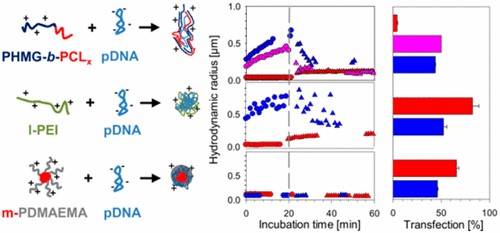News
Compaction and Transmembrane Delivery of pDNA: Differences between l-PEI and Two Types of Amphiphilic Block Copolymers
15.02.2017
Compaction and Transmembrane Delivery of pDNA: Differences between l-PEI and Two Types of Amphiphilic Block Copolymers
A.Raup, H. Wang, C.V. Synatschke, V.Jérôme, S.Agarwal, D.V. Pergushov, A. Müller and R.Freitag Biomacromolecules 2017, 18 (3), pp 808–818.

Polycations are popular agents for nonviral delivery of DNA to mammalian cells. Adding hydrophobic, biodegradable, or cell-penetrating functions could help to improve their performance, which at present is below that of viral agents. A crucial first step in gene delivery is the complexation of the DNA. The characteristics of these “polyplexes” presumably influence or even determine the subsequent steps of membrane passage, intracellular traveling/DNA release, and nuclear uptake. Herein, polyplexes formed with linear poly(ethylenimine) (l-PEI) are compared to complexes generated with functionalized diblock copolymers. While l-PEI interacts only electrostatically with the DNA, interaction in the case of the diblock polymers may be mixed-mode. In certain cases, transfection efficiency improved when the polyplexes were formed in hypertonic solution. Moreover, whereas conventional PEI-based polyplexes enter the cells via endocytosis, at least one of the diblock agents seemed to promote entry via transient destabilization of the plasma membrane.

